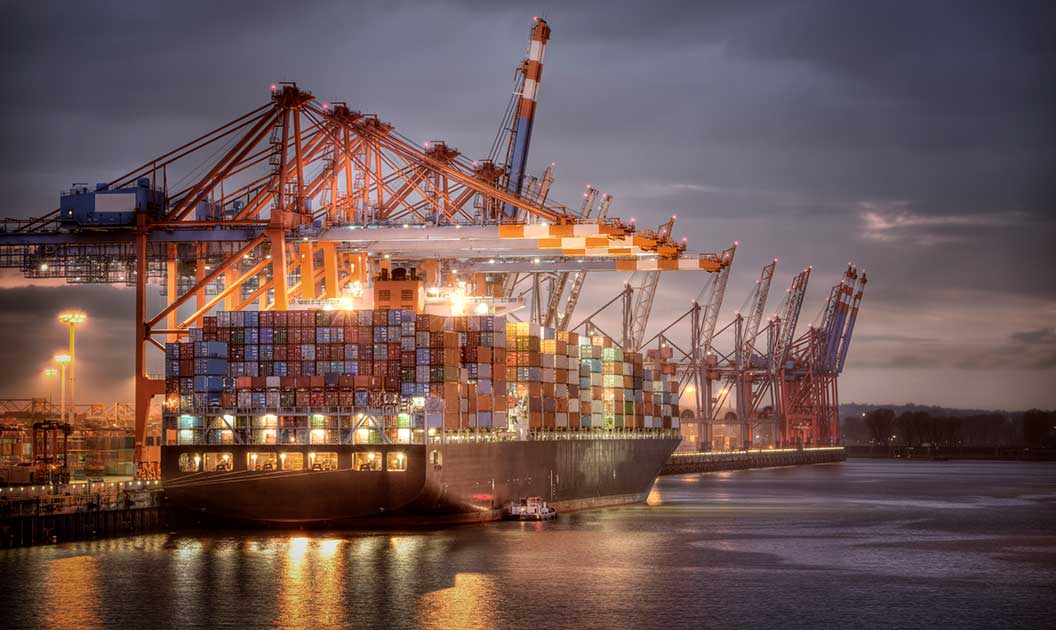What is transloading? With the complexities of freight shipping in normal times, businesses are always looking for solutions to get their goods transported faster, more efficiently and at a reasonable rate. During trying times, those same companies need more creative methods to get the same job done. That’s where this flexible transportation service shines.
The Council of Supply Chain Management Professionals (CSCMP) defines transloading as the process of transferring goods from one mode of transportation to another during the journey from manufacturer to end consumer. Products are moved from a truck to a train, or from a ship to a truck, as a part of the shipping process.
This is your comprehensive guide to every aspect of transloading in shipping in logistics. We cover topics ranging from basic definitions to the advantages and benefits of transloading. We’ll also show you how partnering with Transload Services USA can boost your business’s shipping efficiency and speed.

What is the Definition of Transloading?
Transloading occurs when a shipment is moved from one method of transportation to another in order to complete the journey. An example of this is when a shipping container begins transport via rail, but can’t make the entire trip via that mode of transport. The container would then be loaded onto a truck to make it to its final destination.
Transload isn’t limited to rail and truck transport. Planes and ocean freight vessels can be part of the process as well. For instance, a shipment from a cargo vessel could be loaded onto a train and then offloaded to a truck. This might not seem complicated, but, it’s often the most efficient and timely shipping solution.
- Freight containers unloaded at a port
- Freight goes into a separate container, on either a truck or train
- That shipment travels to the end point, OR:
- The shipment is transloaded again, from a train to a truck
- The truck takes the freight the rest of the way to its destination
It might seem wasteful to move the freight an extra time, but sometimes it’s the best option. There are four main modes of transportation, and only one of them — trucks — can arrive directly at its final destination for unloading. For this reason, trucks are almost always involved in transloading.
What Does Transload Freight Mean?
Any imported goods that aren’t from Mexico or Canada are going to come to the U.S.via ocean or air transport. Once the freight gets here, it turns into transload freight as soon as it’s offloaded and then put onto a different mode of transportation.
Transloading is sometimes referred to as cross-docking when it takes place in a warehouse setting. However, this is technically a different logistics strategy, which will be discussed later on.
What is Transloading in Logistics?
Remember, the basics of transloading in logistics are as follows.
- Freight is initially transported via a method that can’t be used to reach the end user
- The freight is offloaded one or more times to different modes of transportation in order for it to reach the last mile
- Planes, freight trains, ocean cargo vessels, and trucks can all play a part in transloading
While this process can seem complicated, it has advantages that can’t be overlooked.
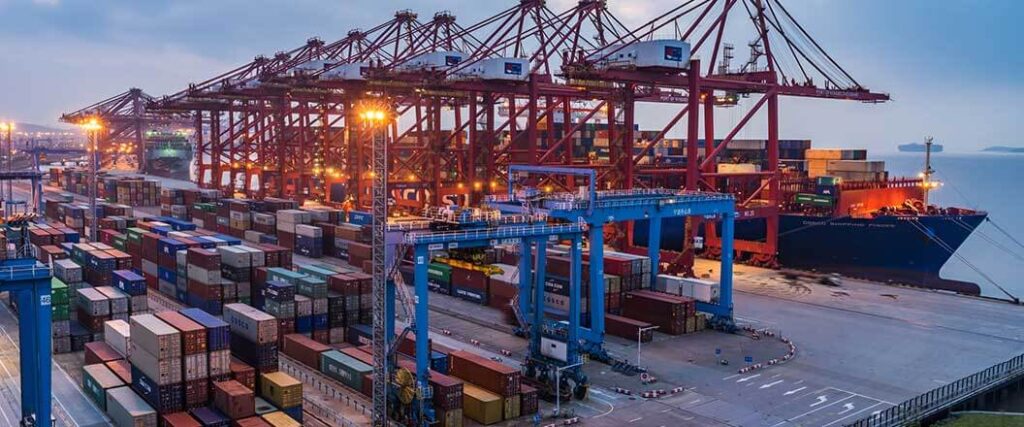
How Does Transloading Benefit the Supply Chain?
Transloading has many benefits in the supply chain, and should be considered for your freight hauling needs whenever intermodal shipping comes into play. In fact, this process alleviates some of the biggest pain points in modern freight shipping.
John Kilbride, our Director of Fulfillment and Distribution, said that it can be a big help in one commonplace logistics issue.
“The logistics industry has been under pressure from a number of directions,” Kilbride said, “One area that has hit many of our customers hard is the difficulty of getting their product out of the ports. Often, they are faced with delays due to a lack of available equipment and no place to put their product. To help our customers, we are offering our services for transload and cross-docking.”
Besides just trying to find a way around shipping delays, a transloading service:
- Improves Supply Chain Flexibility: Transloading can be used in conjunction with cross docking to give retailers greater options when freight shipping.
- Allows For Business Growth: Improving supply chain flexibility and bandwidth means shippers can reach areas they otherwise couldn’t. This extends market reach and offers greater opportunities to grow your business.
- Consolidation Of Shipments: Consolidation on the front end can help you avoid needing multiple containers and/or spots on a boat, rail, plane, or truck. In the long run, this can save you both space and money.
- Speeds Up Shipments: Transloading keeps your shipping agile amid the various hurdles of the modern-day supply chain. By keeping freight in motion, shipping times are reduced.
- Reduces Overall Costs: While there are fees associated with transloading, it’s often cheaper than alternative, more direct shipping methods, such as exclusively using air freight and trucks. It can also reduce warehousing costs since items don’t sit for days and weeks on end.
This is not true for every situation, but the list of modes of transport from least to most expensive would generally be:
- Ocean freighter
- Rail
- Truck
- Plane
A good transloading strategy benefits shippers and customers alike by reducing costs, decreasing shipping times, and streamlining the overall shipping process.
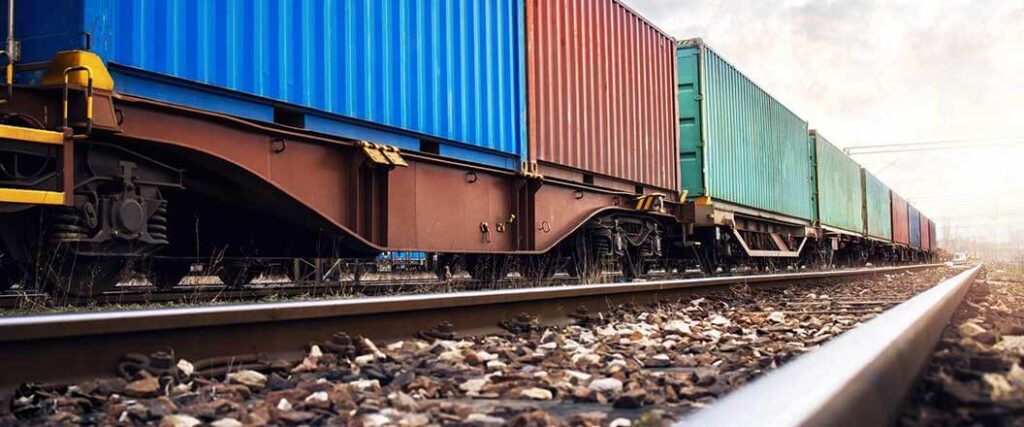
What is the Transloading Process?
The most fundamental aspect of transloading involves one vehicle or shipping container to be 100 percent unloaded. The freight that comes off the first vehicle then is loaded onto another. It can be a different type of vehicle or even the same kind — it’s still all transloading.
To be considered transloading and not a different kind of shipping, cargo cannot stay in the original shipping container or vehicle. For light freight, a simple conveyor belt might be used to move freight between points. For heavier or palletized freight, machinery such as forklifts and cranes is often used to transition the commodities.
What is an Example of Transloading?
Let's consider a shipment of lumber from Canada that needs to get to a construction site in the United States. Here's a simplified example of how transloading might work in this scenario:
- Step 1: The lumber is initially transported by a semi-truck from a warehouse in Canada to a rail yard.
- Step 2: At the rail yard, a forklift is used to transfer the lumber from the semi-truck to a rail car. This rail car will then transport the lumber across long distances to a rail yard in the United States.
- Step 3: Once the rail car reaches its destination, a forklift again transfers the lumber, this time from the rail car to another semi-truck.
- Step 4: Finally, this semi-truck carries the lumber to its end destination: the construction site.
In this example, transloading allows the lumber to be shifted between different transport modes, ensuring it reaches its destination in a timely and cost-effective manner. Each step is crucial, and meticulous coordination is needed to avoid any mishaps.

Enhanced Freight Rework Services
Transloading Rail to Truck
This is a popular method of transloading because it combines the savings of using rail with the directness of a truck to deliver products right to the door of retailers.
To illustrate how this would work, let’s use a specific instance.
- Commodities enter the Port of Los Angeles.
- They need to reach Chicago, which is a 2,000 mile journey.
- If expedited shipping is not a requirement, rail is the most efficient mode of transit.
- The goods can be transloaded from the rail closer to the point of delivery, with the truck easily driving into downtown Chicago to the customer.
Everyone’s business needs are different, but for a lot of shipments, this is a good example of how transloading works in a real-world setting when being planned out.
What Does a Transloader Do?
A transloader is a logistics professional who specializes in moving shipments from one mode of transit to another. At a transloading facility, there are a variety of different roles these professionals can fill. Each one plays a huge part in the positive outcomes.
Some of these roles include:
- Transload Facility Manager: This person makes sure the entire facility is operating at high capacity with an eye toward preventing both workplace injury and damage to the freight. Any issues at the facility end up on this person’s desk. Facility managers have to wear many hats, manage several employees, and be ultra-organized to be successful in their role.
- Transload Operator: This job includes moving all types of freight and the standard operating procedures of the transloading facilities being worked at. Many transload operators are asked to travel to different terminals for work, so that should also be a consideration for anyone interested.
- Freight Conductor: A freight conductor’s role is to coordinate the crews on each train and get the various cars in position for loading and unloading. This is a specially-trained position that requires months of training, both in a classroom setting and on the job, before it can be worked independently.
- Lumper/Warehouse Worker: This is someone who’d operate a forklift while also helping to verify shipment quantities and overall accuracy. This can be a general job with many responsibilities (including keeping the transload facility clean) but organized. Hard-working, fast-paced people who can also work safely are prized for this position.
In addition to these specialized roles, transload facilities also require certain equipment and tools to get the job done.
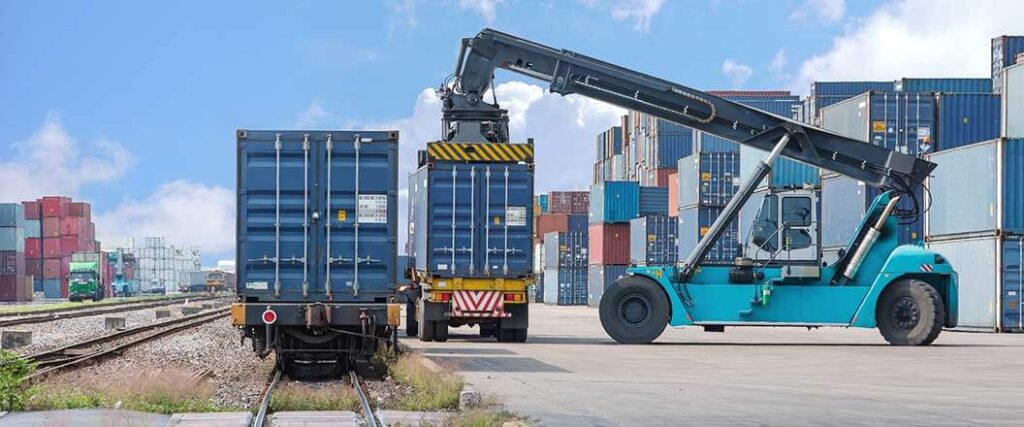
What Kind of Equipment is Needed for Transloading?
Depending on the commodities involved, there are many different types of equipment that can be used to complete the transloading process. The following list contains just a few of those pieces of equipment.
- Conveyors: Conveyor belts are instrumental in being able to quickly move boxes from one form of transportation to another. They can be set up between both points of a transload so that heavy goods can be easily transported across long distances.
- Forklifts: Forklifts are commonplace in distribution centers and warehouses. However, they can also be used at transload facilities. These machines can easily move pallets filled with freight.
- Cranes: Cranes are used to pick up entire shipping containers and move them wherever desired. They’re used at ports of entry as a reliable means of unloading shipping containers. They are also handy in scenarios where break-of-gauge is in place as a way to circumvent that roadblock.
- Pumps: These are used to transfer gasses and liquids from one container to another. The two pumps used in the transloading process are sliding vane pumps and reciprocating gas compressors.
A sliding vane pump uses a rotor to pull the liquid behind each of the sliding vanes and into a pumping chamber. It’s ideal for transferring liquid from a tanker on a train to a tanker truck, or vice versa.
In a reciprocating gas compressor, gas enters one end, then is put under high pressure through compression to move it into the second container.
Commodities transloaded by pump can include:
- Milk
- Animal feed
- Gasoline or crude oil
- Propane
- Hydrogen Peroxide
- Nitrogen
- Natural gas
The tools mentioned above are crucial to the practice of moving commodities between containers. Let’s take a closer look at the containers themselves.
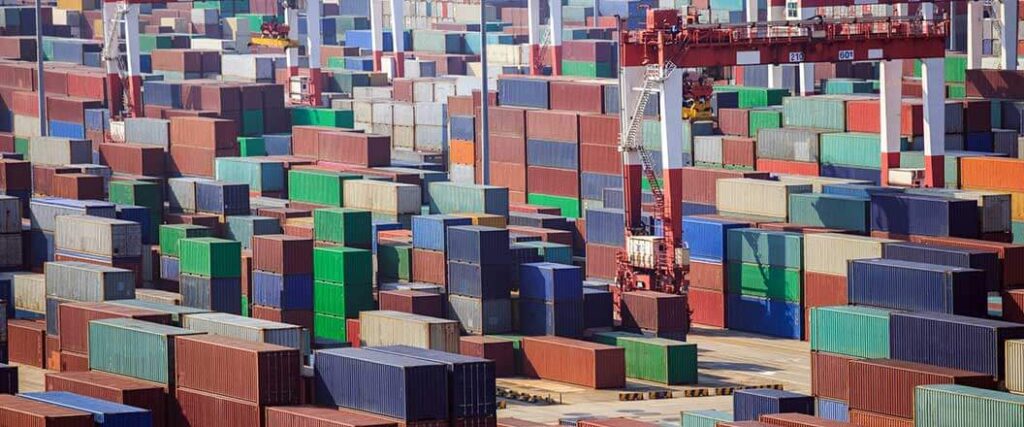
What is a Transload Container?
A transload container is a shipping container loaded onto a boat, a train or — in less common cases — a flatbed truck. The container itself helps the freight travel part of the trip until the actual transloading begins. Once that happens, the container is then emptied either into another shipping container or into the back of a freight truck.
Most containers used in container transloading start their journey internationally and are known as ocean shipping containers. There are many sizes, but the three most common are listed in the table below.
| Container Name & Length | Width | Height |
| 20-Foot Shipping Container | 92.5” | 94” |
| 40-Foot Shipping Container | 92.5” | 94” |
| 40-Foot High Cube Container | 92.5” | 105” |
| 20-Foot High Cube Container | 92.5” | 105” |
On the other hand, an intermodal container has slightly different dimensions, at 8.5 feet tall by 8 feet wide. This size is easier to use on multiple modes of transport.
What is a Transload Facility?
A transloading facility is a staged area where the swapping of freight from one mode of transportation to another occurs. When the facilities are outdoors, the location often needs to be accessible by both trains and trucks. Typically, they are by railroad tracks that are near highways.
While railroads play an important role in logistics, there are a lot of businesses, stores, and even warehouses that don’t have tracks leading right to them. That’s why transloading facilities exist.
Transloading and the corresponding facilities play a huge role in freight movement in the face of massive port congestion, something Kilbride was quick to point out.
“In a transload situation, we can bring their product to one of our locations – Ocala (Fla.), Atlanta or Los Angeles,” Kilbride said. “We can take their product out of the container and load it onto a truck or trucks for delivery. The services allow the customer to get their product out of the port, avoid high demurrage costs and late fees, which can run into the thousands [of dollars].”
Kilbride’s comment about his company’s locations is certainly an important point about transload facilities. Like many aspects of freight transportation, transloading is more efficient in strategic areas of the United States.
While the proximity of Atlanta and Los Angeles to many people in their respective regions is inherently understood, Ocala deserves recognition as well. Its strategic location in North Central Florida can easily reach all the state’s nearly 21.5 million residents in a matter of hours.
Three of Florida’s biggest cities — Orlando, Tampa, and Jacksonville — are within a two-hour drive from Ocala. The Miami and Atlanta areas can be reached in less than a day.
What Does a Transloading Facility Have?
Let’s look at exactly what a transloading facility should have and how these items and employees contribute to the transload process.
- Workers: These can range from laborers needed to shift commodities from one kind of transport to another, to facility managers and route planners.
- Machinery: These can include cranes, forklifts, conveyors, and even pumps. Large amounts of potentially heavy freight require the right tools and equipment when muscle isn’t enough.
- Staging Area: This can be indoors or outdoors, alongside train tracks, or even at a distribution center. A staging area where goods can be easily loaded and unloaded without jamming up any other supply chain work is vital to transloading.
- Easy Access to the Interstate: This is a must when trucks are part of the transload process. The transload facility should be located where 18-wheelers can reach them easily and offer simple on and off-the-road access. Transloading facilities need a lot of space, so they can’t always be located right next to major highways.
Whether it’s manpower or machinery, transload facilities rely on both to satisfy the needs of shippers and, in turn, customers.

What’s the Difference Between Transloading and Transshipment?
Transshipment actually has more in common with intermodal transportation than it does transloading. During both intermodal and transshipment, the shipping container itself is moved. This means the freight inside is not unloaded until it reaches the end of the line.
Transshipment differs from intermodal shipping and transloading because it specifically refers to the movement of a container from one ship to another before it is then shipped to another spot. Both transloading and intermodal shipping can utilize all the different modes of moving freight to complete a single journey.
The act of transshipment can also occur at sea or in waterways near the port of entry. This is used to connect ports around the world that might not have direct access to one another. This limited access can be a result of many factors, including too much time or resources being needed to reach certain ports.
It can also be used if the desired port is congested or unavailable due to low tide. Transshipment practices must align with U.S. Customs and Border Protection regulations. Some countries use the practice to avoid tariffs or trade restrictions, which America deems to be illegal.
What’s the Difference Between Transloading and Cross Docking?
Transloading and cross docking are two logistics strategies used to expedite the transport of goods, but they’re different in their approach and process. To highlight how they differ, let's take a look at some scenarios where each practice is applied.
Transloading Example: A shipment of apples grown in Washington state needs to be distributed to various locations across the country. The apples are loaded onto a truck, which transports them to a nearby rail yard. From there, they are transferred to a train that transports them to different states. Once the train reaches its destinations, the apples are again loaded onto trucks for final delivery to individual stores.
Cross-Docking Scenario: A shipment of electronics arriving from a manufacturer. These electronics are received at a warehouse dock and are immediately unloaded and sorted. Instead of being stored, they are immediately reloaded onto outbound trucks at the other end of the dock based on their different destination points. The goods spend minimal time in the warehouse, primarily just being moved from one truck to another.
Let’s now outline the main differences between these two examples.
- Types of Commodities
Transloading: Often involves bulk or loose goods, like raw materials, including fruits.
Cross Docking: Typically involves finished products ready for sale, like electronics.
- Storage
Transloading: Goods might be temporarily stored between transitions.
Cross Docking: Goods spend very minimal to no time in storage; they are immediately transferred to outbound trucks.
- Handling
Transloading: Goods are often handled more, as they might be repackaged or broken down into smaller shipments between transports.
Cross Docking: Goods are handled less, with the aim being to transfer goods from inbound to outbound transport as quickly as possible.
- Purpose
Transloading: Primarily used to transfer goods between different modes of transportation, optimizing for cost, speed, and efficiency.
Cross Docking: Used to minimize storage time and get goods to their destination quickly, reducing the need for warehousing space and costs.
Remember, the choice between transloading and cross-docking depends on the specific needs and requirements of the shipment. Sometimes, a combination of both might be used to achieve the optimal logistics solution.
According to Kilbride, cross docking can be worth looking into in cases where it might be preferable to transload.
“In a cross dock arrangement we can take [our customers] product out of the ports, unload the containers and store the product short-term — normally a few days or weeks at a daily charge — then load it on a truck or trucks when they have arranged a location for delivery,” he said.
Cross docking is another avenue that you can take when trying to navigate the supply chain. It’s important to analyze the differences between it and transloading and make the determination on which will be right based on your exact needs, or availability, at the time.
What is a Cross Dock Terminal?
Having covered what cross docking is and how it takes place at a distribution center or warehouse, let’s zero in on what the actual cross docking terminal itself is. We’ll also examine its role in successful freight operations.
Cross docking terminals are elevated dock doors in the sides of the building that allow trucks to back into and be easily unloaded. They have roll-down doors or shutters to close the openings when they are not in use. Sometimes the fit isn’t perfect, so ramps are used to bridge the gap between the truck and the entrance to the distribution center.
The trucks are unloaded on the inbound side of the center. Once in the warehouse, the goods are sorted so that they end up on a corresponding truck on the outbound side of the facility. This can be as straightforward as rolling a pallet across the way on a pallet jack or forklift and going right onto an outbound truck. In other cases, it can require the pallet to be broken down and resorted so that it can go onto different trucks.
On the outbound side, the goal is to position the freight to be quickly and correctly loaded once the vehicle arrives.

What Is The Difference Between Cross Docking and Break Bulk?
Different logistics strategies, such as transloading, cross docking, and break bulk share similarities. It might be difficult to find the defining characteristics of each that truly separates one from the other.
However, when drilling down a little deeper, there are contrasts that justify naming them as different types of shipping. This holds true with cross docking and break bulk. Let’s quickly list some of the similarities before diving into why they’re not the same.
Similarities
- Takes place in a warehouse.
- Involves inbound freight being unloaded and then reloaded onto an outbound truck.
However, it’s what occurs while in the warehouse that cross docking and break bulk separate services. Cross docking is usually the process of taking palletized freight and moving it across the distribution center to another truck to complete the rest of its journey. Sometimes, the pallets can be further broken down to put boxed or packaged items onto multiple trucks.
In the case of break bulk, goods are completely broken down so that a customer or retailer can receive a smaller quantity to their exact specifications.
Break bulk is also used when the commodity in question needs to be packaged differently before the customer receives it. It may also be that the items are parts of something that require assembly once they reach the customer. An example would be car parts that will be added to a vehicle for an end product.
In short, many break bulk shipments are really cross docking at the start, with a part of the freight broken off to be put on a separate truck from the cross docked materials.
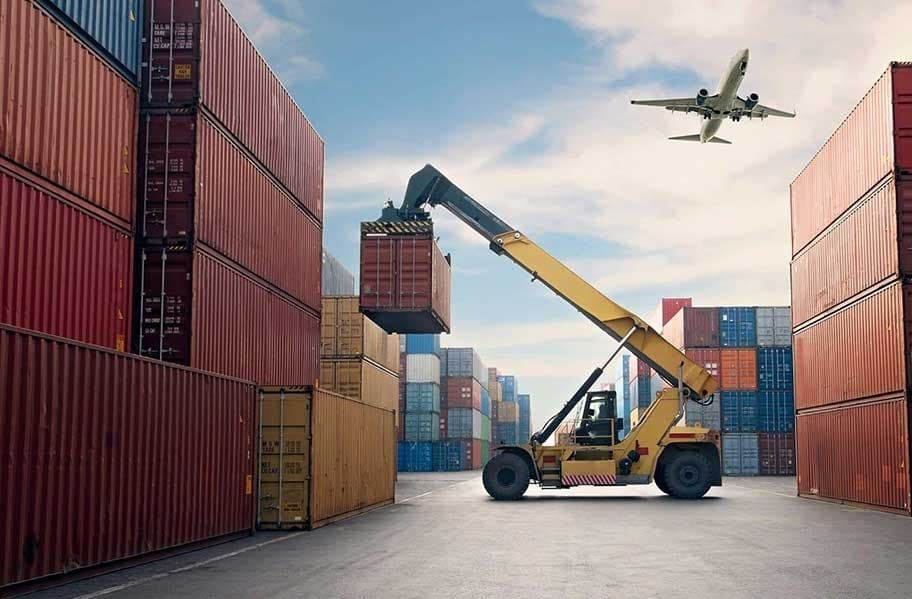
Safe and Secure Transloading Solutions
What Is Intermodal Shipping?
Intermodal shipping simply means that two or more methods of transportation were used in order to complete a single shipment. These methods usually include:
- Cargo Vessel
- Plane
- Rail/Train
- Truck
This might make it sounds exactly like transloading, but a little further down, we’ll explain why they are not exactly the same.
This type of shipping uses special containers called intermodal containers. These allow goods to be easily transferred between trains, trucks, and cargo ships in a seamless manner.
In today’s climate, it’s rare for a single shipment of goods to be completed through just one transportation mode. In fact, with the current truck driver shortage, intermodal shipping is on the rise.
Railroads account for one in four shipping dollars for intermodal transportation in the United States.
The main difference between transloading and intermodal shipping is as follows:
- In transloading, the goods themselves are taken out of one vehicle or container and moved to another one, so the original shipping container doesn’t continue to hold the freight.
- During intermodal shipping, the entire shipping container is moved, so the freight itself is never unpacked until it reaches a distribution center or its final destination.
Like transloading, intermodal shipping is another option to move goods through the supply chain. It can be used to great effect, as can transloading, and is another option to ponder whenever you need freight moved.
What is Drayage?
Drayage refers to a short trip for freight, usually in the same area as the port through which it enters. Drayage shipments are used to haul freight over small distances and function as a connector inside the supply chain.
An example of this would be if shipping containers arrived in the port of Jacksonville or Tampa, and then were transferred to a truck, either still in the container or via transloading. This freight would ship to a distribution center in Ocala to be sorted out or even cross docked before it’s ready to be sent to its final location for sale.
Drayage might cost an additional fee, or be included in the quoted price for a complete movement of freight. It is never a standalone service, though, since its sole purpose is to act as the ‘first mile’ of the overall journey.
However, drayage doesn’t always have to be just a short jaunt from a port. It can originate at the port, but may need to go to a yard or warehouse before its leg of the move is over.
Drayage isn’t just an option, but a necessity in some regards. This is because it often begins the flow of commodities into the U.S., and alleviates congestion at the point of entry.
Additionally, drayage can reduce costs because the freight is on the move rather than sitting at a port and incurring demurrage fees. These are charged to the importer when their freight isn’t unloaded or removed within the agreed-upon time.
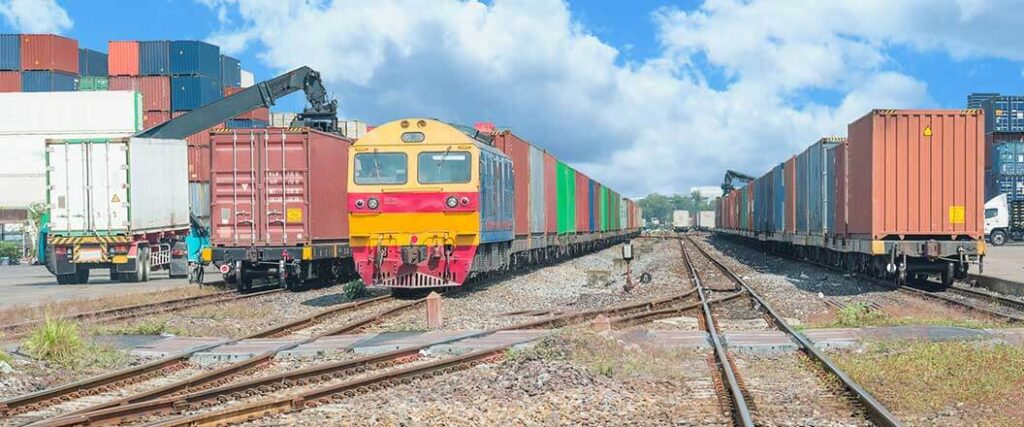
Is Transloading the Same as Intermodal?
By its most general definition, transloading is a form of intermodal shipping because it also uses two or more modes of transport. So at a basic level, yes, transload shipping is the same as intermodal shipping. However, there is one major differentiator between the two that does make them slightly dissimilar. That is the way the freight is transferred in between transportation vehicles.
Intermodal: With this kind of shipment, the cargo is in shipping containers that they stay in for the duration of the journey. So while the shipping containers can freely be moved between trucks, planes and trains, it is not offloaded from the containers until the end of the trip.
Transloading: On the other hand, as previously mentioned, transloading also employs multiple transportation methods. However, it doesn’t stay in the same shipping container the entire journey. In fact, whether it’s through muscle or machine, a train car (for instance) is fully unloaded and then re-loaded into the back of an 18-wheeler or onto the flatbed of a truck.
To a certain degree, these two kinds of transportation can work in tandem.
Why Do I Need Transloading Services?
A major reason why transloading services are used is that they’re essential in making sure your freight can get from its starting point to its end destination.
No one would have come up with the idea of loading and unloading freight mid-journey unless there was an advantage in doing so. Simply put, the most basic modes of transportation — rail, boat, plane, and truck — all have limitations.
Shippers will run into the following issues within each mode:
- Plane: Planes can only land at airports or airfields, so you still need another form of transport to complete the rest of the delivery. Also, planes are always going to be the most expensive option.
- Boats: Marine vessels are typically the slowest way to move goods from point to point. It’s further limited by relying on a rail or truck to actually deliver the commodities once they reach port.
- Rail: Rail is usually the most environmentally friendly and cost-efficient option for domestic ground. However, trucks can rival it on cost, and rail still needs a truck to complete the last mile.
- Trucks: While extremely versatile, its capacity is very limited. Unless your ground shipments are traveling to Mexico or Canada, they aren’t an option for international shipping.
No single mode can be used every single time for 100 percent of the hauling. That is why services like transloading and others mentioned have evolved within the supply chain.
Is Transloading Right for My Business?
No one knows the exact needs of your business other than you, but it’s safe to say that transloading helps more and more businesses every day. With the supply chain being more globally oriented now than at any other time in history, goods often travel thousands of miles on multiple types of transport before reaching the end of the line.
To decide if transloading is right for your business, ask yourself these questions:
- Is transloading your best option to move freight?
- Will transloading save you time and/or money?
- Does transloading cut down on potential delays?
If you can answer affirmatively to even one of these questions, then transloading is right for your business.
Another point to consider is how many boxes or containers need to be transloaded. In transloading, the more individual pieces of freight that must be moved at a transloading facility, the more it will cost the person or business having the commodities shipped.
Whether you need to transport granular goods, like sand, frac sand, or soda ash, fresh produce like agricultural products, or bulky cargo like coal, there is a transloading option for your business.
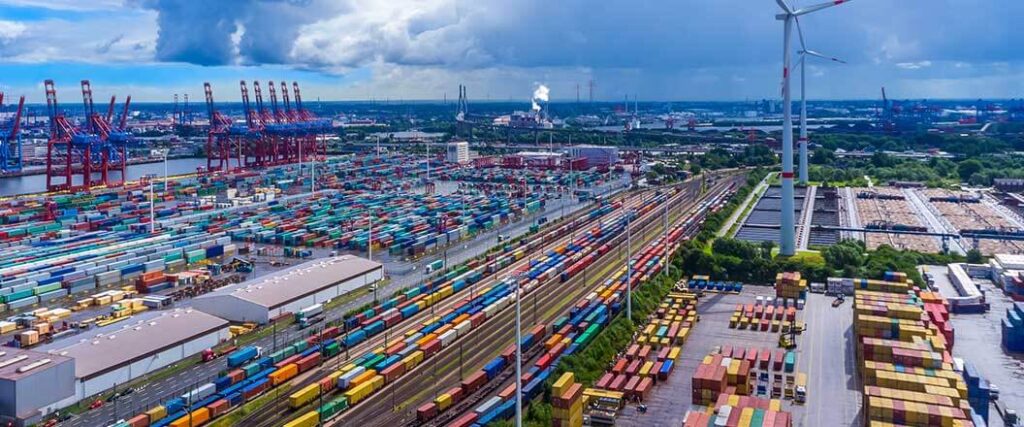
What Are The Benefits of Transloading?
First and foremost, transloading will benefit you if you’re looking for a way to cut down on possible shipping delays. If your goods originate from overseas, transloading won’t help them clear customs any faster, but the domestic leg of the trip is sped up
Transloading can also save you money over traditional long-haul trucking or railroads. This is by using several methods of transport to complete that journey, or avoiding costs associated with long-term storage of cargo.
Finally, sometimes transloading is simply the best option to ensure cargo reaches its destination in the United States. If freight has to go from Houston to Denver, transloading might be superior to having the goods take a train or truck the whole way.
How Does Transloading Reduce Costs?
Transloading can reduce costs by employing cheaper transportation (such as rail) for the majority of the trip. Once the railcar can’t go any further, having transload take place by moving your goods to a truck completes the rest of the movement.
The other way in which it can help reduce costs is by bypassing warehousing fees. Storage fees can add up quickly. Thankfully, transloading can cut them down..
The less time your freight spends sitting around, the cheaper your freight transport should be. Earlier, drayage was talked about as a way to keep your freight on the move so demurrage costs were not incurred. That principle can also apply to why transload works as well to avoid excessive and unnecessary fees.
Another way to save money comes from the consolidation of freight during the transloading process. For instance, the content from three of the 40-foot ocean containers can fit inside a pair of the United States’ 53-foot dry vans. It all depends on how it’s packed.
Fewer containers reduce overall shipping costs.
How Can I Integrate Transloading into My Transportation Plan?
The easiest way to integrate transloading into your transportation plan is by partnering with a third-party logistics company. With their help, it’s possible to determine whether it makes fiscal sense to use the process.
In many cases, you would not be the one to decide whether your freight will be transloaded. In fact, it will more than likely be offered as a suggestion once you tell the 3PL from where your freight will originate and its final destination. At that point, the feasibility of transloading will come into focus.
As always, your goal should be to have your freight moved in the safest, most direct way with an eye on value. That doesn’t always mean going with the cheapest method of shipping, but having an understanding of the best combination of the cost and the services included with that.
Implementing Transloading Strategies
Transloading can improve efficiencies overall when used to move freight, but it is not a simple set-it-and-forget-it proposition. Like many of the aspects surrounding the supply chain, a strategic application provides the best results.
Your third-party logistics provider should be as interested as you are to conserve resources. An efficient transloading strategy helps you and the carrier make get the most out of shipping services.
Strategies can be used with cross docking as your go-to for order fulfillment services. Similarly, it can just be another option within the confines of transloading to get your freight exactly where it’s desired.

What Commodities are Best for Transloading?
In America, the most common transloading takes place from rail transport to a truck. Many commodities can benefit from this logistics strategy.
To give you an idea of why transloading is used and its place in the supply chain, let’s look at a few types of freight that are particularly well-served by transload.
- Oversized or heavy freight
- Palletized goods
- Perishable items
Steel beams are a great example of a commodity that greatly benefits from transloading. Metal products can be shipped in a rail car and then transloaded at a facility onto a commercial flatbed truck to finish its journey.
Building materials are a popular category for transloading since their durable, heavy construction is well-suited for truck and train travel.
Furthermore, almost any class of household goods can be transloaded. This can be anything from clothing to electronics to even home furnishings. If it’s easily boxed or palletized, it’s good to go.
What Are The Major Challenges of Transloading?
Transloading, while beneficial, comes with its set of challenges. These challenges are mainly in the execution, implementation, and management of the process.
Some of the challenges that companies encounter include:
- Coordination Complexity: Managing multiple transportation modes requires intricate planning and coordination, and any misstep can cause delays.
- Increased Handling: Goods often need to be repackaged or reconfigured between transport modes, increasing the risk of damage or loss.
- Cost Management: Balancing the costs involved in transloading, such as handling and storage fees, can be tricky and may impact the overall shipping cost.
- Regulatory Compliance: Different transportation modes and international shipments necessitate adherence to varied regulations, which can be challenging to navigate.
- Inventory Management: The need for accurate inventory tracking increases with every transition, making efficient inventory management crucial.
- Customization Requirements: Different goods may have specific handling and transport needs, requiring customized solutions that can be complex to implement.
- Real-Time Visibility: Maintaining real-time visibility into goods' location and status is crucial, but can be challenging due to the multiple handoffs involved.
- Time Constraints: Synchronizing different transportation modes within tight schedules is often necessary, which is difficult to execute consistently.
Overcoming these challenges requires experience and knowledge of logistics. Partnering with a 3PL can mitigate these challenges significantly. 3PLs offer expertise in managing complex logistics processes, including transloading. Leveraging the capabilities of a 3PL allows businesses to focus on their core competencies while ensuring the smooth and efficient handling of their transloading needs.
How Can I Overcome Transloading Challenges?
One way to guard yourself against the damage that may occur during transloading is by protecting the cargo with freight insurance, which will be covered in the next section. This is one of the biggest challenges you’ll encounter in regard to transload since it increases the number of times that freight is handled and can increase its chances of being damaged.
Another way you can overcome this challenge is by making sure your freight is packaged as securely as time and cost allow for. Sturdy, comprehensive packaging will give your products a better chance of surviving shipping.

Freight Insurance for Transloading
There are some who feel like transloading might not be right for their business because it increases the amount of time that their shipment is handled and moved. This can be true in some circumstances. However, you should not rule out using transloading just for this reason.
While there is no way to completely mitigate the risk of freight suffering from damage, you can absolutely protect yourself financially by making sure you purchase freight insurance. This insurance is above and beyond what the freight company would have to cover in case of an accident.
Keep in mind that the bare minimum coverage offered by freight companies doesn’t insure against certain provisions protected by the Carmack Amendment. This law allows the carrier to provide proof they weren’t responsible for the damage.
Instead, they can cite the following:
- Damage caused by government
- Damage caused by act of war
- An act of God
- The shipper was somehow responsible for the damage
- The product damaged itself (known as inherent vice)
While some of these are more likely to happen than others, it requires the shipper to take the lead on making sure their cargo is not left vulnerable. In this case, all-risk coverage might be what you need. This type of coverage insures your cargo and can cover up to the entire value of your freight. Obviously, the higher the value of your freight, the more expensive it will be.
It will add an expense, but in the event of an unforeseen occurrence, it could save your investment.

Affordable TransloadingServices For Your Business
What Should I Look for in a Transloading Company?
Picking the right transloading can seem difficult. However, there are a few things you can look for in any provider of these services to make the most informed decision.
You want a logistics company that has capable equipment to efficiently and properly get the task of transloading accomplished. This includes train tracks or stations located not far from America’s interstates, so trucks can get off and on the road quickly to load up.
The 3PL you’re looking for should be your partner in every sense of the word. You should go with a trusted company that has experience in transloading. A company that takes timeliness and customer service seriously and not just as buzzwords to throw out there.
The 3PL should be able to provide other services as well.
- Temporary storage
- Warehousing
- Intermodal capabilities
- Cross docking
Diverse service offerings provide your company with its best chances at success.
How to Find a 3PL Partner for Transloading
In many cases, finding a preferred partner for transloading isn’t a difficult proposition. However, there are a few different ways you can choose to go about this decision.
Those in the business world who are well-connected can use an old-fashioned method to gather more information: ask a friend in the business. People you trust will usually be best positioned to give you meaningful feedback on the strengths and weaknesses of a 3PL that they’ve personally interacted with. This can be invaluable in assisting in the decision-making process.
It’s also worthwhile to search for information and reviews online. In this case, it is of paramount importance to make sure the reviews are legitimate if you are going to base such a crucial choice on them.
You can also contact 3PL providers directly. By asking the right questions you get a much better idea of the services they render, the costs associated and even timeframes. All of these factors play an important role in informing your decision.
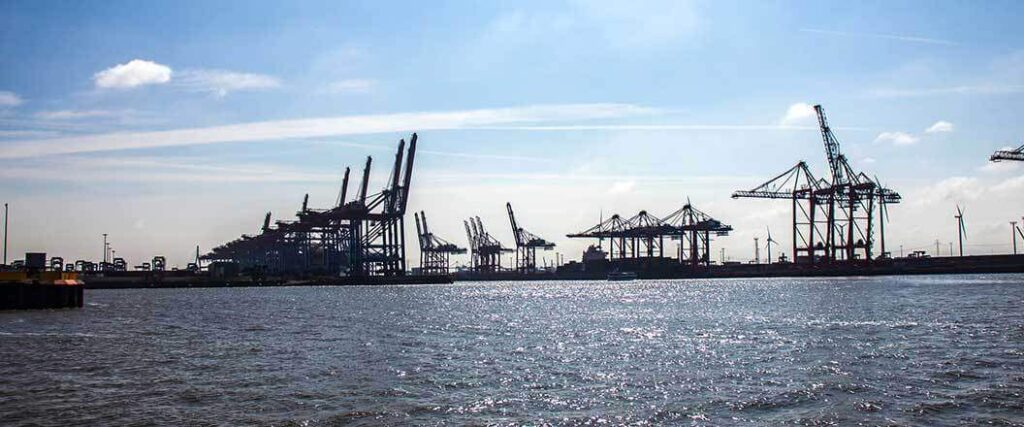
What Are the Benefits of Working with a 3PL Partner?
The benefits of working with a 3PL partner are numerous. The general answer comes first — working with a 3PL partner gives you access to help across the entire supply chain. For the right price, they can completely take tasks off your plate. For those who wish to retain more control, benefit from different levels of involvement
Let’s take a closer look at the individual benefits of employing this type of partner.
Transportation
Third-party logistics will make sure your freight stays on the move. Many offer the four major forms of transport. A 3PL can either own the assets themselves or form strategic partnerships directly with the operators and work with them to book loads.
Neither is necessarily better than the other, but they’re two different ways that a 3PL will make sure they’ve got capacity to have your order able to be moved. Viable 3PLs should also be able to give you sound advice on what the best mode of transportation is for your individual scenario.
This includes transloading, but it also encompasses services such as:
- Refrigerated trucks
- Expedited shipping
- Heavy haul or oversized trucking
So no matter how you want or need your freight moved, your 3PL should provide the benefit of giving you various options.
Warehousing
Since timing doesn’t always work out, it may be necessary to store your cargo temporarily. A 3PL can certainly help with that. Whether it’s a few months in the lead-up to the holiday season or as part of a years-long plan, they’ve got you covered. The provider will have warehouses in desirable locations across the United States to allow storage and transportation hubs.
While your freight is in storage, it will be protected and eligible for additional services such as order fulfillment, pick and pack, kitting and even reverse logistics (aka product returns). Without using a warehouse in some regard, you won’t have access to any of these services.
Cross Docking
With this form of transload, a truck reaches a distribution center, unloads, and the cargo is placed on an outbound truck to continue the rest of the journey. Sometimes this type of freight movement is necessary to get all the way through the supply chain.
Like other benefits, this might not be something you feel like you initially need. However, having the option can be an integral part of moving your freight or just helping maintain flexibility should it be an attractive alternative.
Welcomed Assistance
When you start your business, you might know from the start that you’re unable or simply don’t want to have to execute certain steps in the supply chain process. This includes clearing, shipping, storing, or distributing your freight.
A 3PL company can help with all kinds of things: clearing customs, filling out the appropriate paperwork completely and accurately, knowing the rules and regulations for importing any commodity, and more. Those can all be a part of your strategy, both domestically and internationally.
Even if you don’t automatically need to lean on your 3PL for any or all of these sorts of things, it’s certainly nice to know you have it available at any point along the road.
What is a Strategic Logistics Partner?
Sometimes shipping is a very straightforward proposition. However, what if you plan on regularly shipping or setting up an order fulfillment agreement? Then you’ll need a strategic partnership with an outfit that knows exactly what it’s doing.
A strategic logistics partner can fully provide crucial help and services to ensure your shipping, fulfillment, distribution and transloading needs are taken care of. This is used so that there’s no doubt that your goods are shipped and fulfilled in the exact way you envision.
If it is transloading, great. If a traditional trip in a freight hauler, no matter the distance or method, is called for, your strategic logistics partner can do that for you too. The strategy in question doesn’t even need to be long-term.
It reflects any time you need a clearly defined plan for your supply chain requirements.
Let Transload Services USA Make Transloading Simple
Now that you’ve received the complete guide to make transloading a simple process, make it even easier by letting Transload Services USA handle all of your transload needs. With us at the helm, your freight will be expertly shipped from the start to finish with great care.
We have all the equipment and strategic locations required to make this a seamless transfer of your precious cargo. With the skilled, knowledgeable workers carrying out this task, your freight is at little risk. We also have access to any mode of transport you require, from trucks and trains to boats and planes. You won’t be limited from a freight-hauling standpoint.
We can also offer additional services, including:
So when you’re ready to employ transloading in your freight handling needs, reach out to Transload Services USA to find out exactly how we can boost your business while using it. For a free quote with no obligation, call us today at (352) 282-4588 to learn more.

